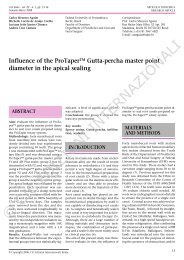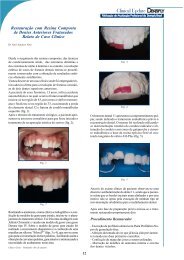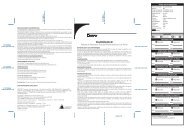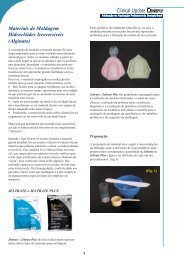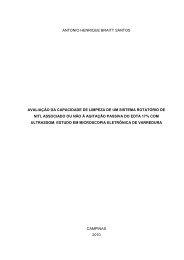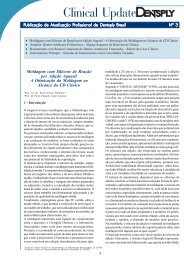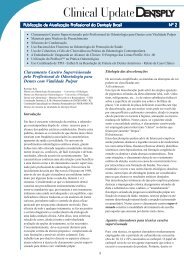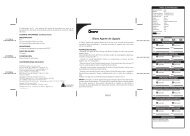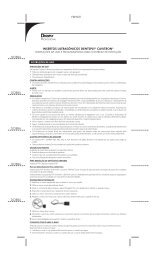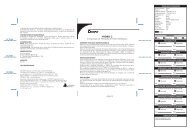Create successful ePaper yourself
Turn your PDF publications into a flip-book with our unique Google optimized e-Paper software.
Clinical Bonding of a Single-step Self-etching Adhesive<br />
in Noncarious Cervical Lesions<br />
Jan WV van Dijken a /Karin Sunnegårdh-Grönberg b /Ebba Sörensson b<br />
Purpose: The aim of this study was to evaluate the clinical retention to dentin of a single-step self-etching adhesive<br />
system.<br />
Materials and Methods: A total of 133 Class V restorations were placed with the self-etching primer Xeno III and a<br />
resin composite (Tetric Ceram) or a polyacid-modified resin composite (Dyract AP) in noncarious cervical lesions without<br />
intentional enamel involvement. The restorations were evaluated at baseline and then every 6 months during a 2-<br />
year follow-up. Dentin bonding efficacy was determined by the percentage of lost restorations.<br />
Results: During the 2 years, 130 restorations could be evaluated. The cumulative loss rate at 2 years was 7.7%, with<br />
no significant differences between the two restorative materials. The self-etching adhesive fulfilled the 18-month full<br />
acceptance ADA criteria.<br />
Conclusion: The single-step self-etching adhesive showed acceptable clinical retention rates to dentin surfaces during<br />
the evaluation period independent of restorative material used.<br />
Keywords: adhesion, clinical, cervical, dental material, etch, resin, restoration, self-etching.<br />
J Adhes Dent 2007; 9: 241-243. Submitted for publication: 15.12.06; accepted for publication: 8.1.07.<br />
a Professor, Department of Odontology, Dental School Umeå, Umeå University,<br />
Umeå, Sweden.<br />
b Assistant Professor, Department of Odontology, Dental School Umeå, Umeå University,<br />
Umeå, Sweden.<br />
Paper presented at Satellite Symposium on Dental Adhesives, Dublin,<br />
September 13th, 2006.<br />
Reprint requests: Prof. Jan WV van Dijken, Department of Odontology, Dental<br />
School Umeå, Umeå University , 901 87 Umeå, Sweden. Tel: +46-90-785-6034,<br />
Fax: +46-90-770-580. e-mail: Jan.van.Dijken@odont.umu.se<br />
The introduction of primers containing amphiphilic monomers<br />
– dissolved in solvents such as water, acetone, or<br />
alcohol to promote wetting of the dentin and replace water<br />
– changed dentin bonding to a more reliable clinical procedure.<br />
These primers infiltrate the nanospaces of the collagen<br />
network, caused by the etching procedure, and create<br />
after polymerization an entangled molecular mesh with the<br />
collagen fibrils. 4 A high micromechanical bond to the dental<br />
tissue can be obtained by formation of the so-called hybrid<br />
layer. In the multistep etch-and-rinse systems, clinical success<br />
is partly operator related. The etching and primer application<br />
steps are critical in this approach. Bonding procedures<br />
not involving phosphoric acid etching, such as the selfetching<br />
adhesives, were introduced in the 90s to simplify the<br />
adhesive procedure and decrease the technique sensitivity<br />
of the etch-and-rinse systems. The simultaneous self-etching<br />
and primer infiltration makes these systems more user<br />
friendly, eliminating the risk of over etching and over drying.<br />
Today, there are two self-etching systems. The two-step selfetching<br />
adhesives have a separate priming step with more<br />
hydrophilic monomers and a more hydrophobic bonding<br />
step. In the all-in-one or one-step self-etching adhesives, one<br />
liquid containing all the components for etching, priming,<br />
and bonding is applied to the dental tissues. Earlier mild selfetching<br />
adhesives showed etching patterns of the enamel<br />
which were not adequate for clinical retention, and some<br />
manufacturers recommended the adjunctive use of phosphoric<br />
acid when bonding to enamel. 5 Incompatibility with<br />
autocuring resin composites and permeability to water<br />
movement after polymerization have been reported for the<br />
first all-in-one adhesives. 14,15 Newer self-etching adhesives<br />
contain more aggressive etchants and showed higher tensile<br />
bond strength compared to established dentin bonding<br />
agents. 7 The aim of this study was to investigate the clinical<br />
dentin bonding effectiveness of a new one-step self-etching<br />
adhesive in combination with a resin composite material or<br />
a polyacid resin-modified resin composite in noncarious cer-<br />
Vol 9, Supplement 2, 2007 241



